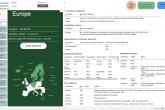PackUK eases 'red' and 'amber' ratings for Recyclability Assessment Methodology
New exemptions for all DRS-covered containers included in RAM update, following simplification sprint with stakeholders.
 PackUK has released an updated version of the Recyclability Assessment Methodology (RAM), introducing simplifications to the framework that determines how packaging producers will be charged under the UK's Extended Producer Responsibility (EPR) scheme.
PackUK has released an updated version of the Recyclability Assessment Methodology (RAM), introducing simplifications to the framework that determines how packaging producers will be charged under the UK's Extended Producer Responsibility (EPR) scheme.
Following stakeholder consultation, the updated methodology removes several criteria that previously led to 'red' or 'amber' classifications across various packaging materials introduced when RAM was first published in 2024. These classifications will directly influence the 'modulated fees' packaging producers will pay under the EPR scheme from 2026, making the changes financially significant for affected businesses.
The RAM assigns ratings to packaging material based on their recyclability across classification, collection, sorting, reprocessing, and application. These ratings directly influence the fees that packaging producers will pay under the EPR scheme from 2026/27. The methodology evaluates individual packaging components against the realities of the UK's current collection, sorting, and reprocessing infrastructure, with the highest (worst) rating at any stage determining the overall red, amber, or green (RAG) status for that component.
| RAG Rating | Definition/Meaning | High-Level Assessment Criteria Influence | Fee Implication |
|---|---|---|---|
| Red | Difficult to recycle at scale; problematic materials/design; negative system impact | Fails criteria at one or more stages (Collection, Sortation, Reprocessing, Application); Automatic Red list items | Highest |
| Amber | Recyclable but with limitations; infrastructure challenges; material loss | May have limited collection, sorting challenges, reprocessing issues, or some material loss | Moderate |
| Green | Widely recyclable within current UK infrastructure | Meets thresholds/criteria across all four stages (Collection, Sorting, Reprocessing, Application) | Lowest |
DRS exemptions expanded
The main aim of the RAM update is to provide more precise and predictable outcomes for material classification to reduce the need for extensive testing, and better align with existing UK recycling infrastructure.
The requirement to apply the RAM affects 'Large Producers' - organisations with an annual turnover of £2 million or more that are responsible for supplying or importing more than 50 tonnes of packaging into the UK per year. These businesses have been required to apply the RAM to their household packaging placed on the market since January 1, 2025, with the first data submission incorporating these assessments due by October 1, 2025.
One of the major changes is the expansion of exemptions for containers covered by Deposit Return Schemes (DRS). The updated version now exempts all single-use drink container packaging within the scope of planned DRS initiatives, regardless of material type.
This change also accommodates potential differences in DRS implementation across the UK, such as Wales' intention to include glass in its scheme.
Version 1.1 has also clarified the automatic ‘red’ classification, which now explicitly includes packaging containing intentionally added perfluoroalkyl and polyfluoroalkyl substances (PFAS), which are known as ‘forever chemicals’. The Environmental Audit Committee has recently announced an inquiry to investigate the UK’s regulatory approach to these chemicals.
Other materials given the automatic 'red' classification include integrated electrical components or batteries, substances of very high concern (SVHC) exceeding specified thresholds, and non-compliant inks.
A significant exception remains for packaging containing PFAS, which will not automatically trigger a 'red' classification if the primary material is aluminium, steel, or glass. This exemption recognises that the established, high-temperature recycling processes for these materials may be less sensitive to PFAS contamination compared to plastics, or that the overall recyclability benefit outweighs the additive concern in these specific streams.
Restrictions eased for paper, plastic, and glass packaging
For paper and board packaging, Version 1.1 has removed the 'red' classification for items containing retained product residue that could not be removed by hand. The guidance now suggests that minor surface staining or crumbs are generally acceptable. The 'amber' classification for the presence of Polyamid epichlorohydrin (PAE), a chemical used to enhance paper's strength, as an additive has also been removed.
Similar changes apply to fibre-based composite materials, with the removal of 'red' classifications for retained product residue and 'amber' classifications for PAE in both liquid and non-liquid cartons.
For plastic flexibles, the 'red' classification based on the presence of carbon black pigment in inks and labels covering more than half of the total surface area has been eliminated.
The changes for rigid plastics are particularly extensive, with the removal of several 'red' classifications previously applied to attached labels or sleeves made of different materials, the use of attached label adhesives on PET bottles that are not removable in a hot wash, and the presence of nanocomposite additives in PET bottles.
Furthermore, several 'amber' classifications for rigid plastics have also been removed, such as those for attached paper labels or sleeves on PET bottles and PP items, heavy colours in PET bottles and PP items, and the presence of clarifier additives in PP items.
For glass packaging, the 'amber' classification for attached labels covering more than 60 per cent of the total surface area has been removed.
New 'red' classification introduced for large steel packaging items
In contrast to the many removals, Version 1.1 introduces a new 'red' classification for steel items larger than 300mm in size, unless they are foldable or part of a recognised take-back scheme.
For wood and "other" materials, the updated RAM clarifies that a 'red' classification applies at all stages of assessment if no national collection or sortation infrastructure exists at scale for these materials.
Implementation timeline and industry response
The RAM is not merely a compliance exercise but requires strategic consideration by businesses. While base EPR fees commence in 2025 (invoiced from October 2025 based on 2024 data), the financially impactful modulated fees, driven by RAM results, will start applying in 2026 based on the 2025 data.
Industry bodies have expressed support for the core EPR aim of making producers responsible for packaging end-of-life costs, while emphasizing the need for the system to be cost-efficient and transparent. However, concerns about the level of technical detail required for RAM reporting have been raised, suggesting it might exceed the data typically gathered by compliance schemes.
Commenting on the updated RAM, Robbie Staniforth, Director of Innovation and Policy at Ecosurety, who also sits on the Steering Group of PackUK, said: "It is pleasing to see the methodology has finally been released after years of discussion about recyclability. The team at PackUK have been working at some pace to complete and publish this work after years of delays by previous Governments.
"Those delays earlier in the process will mean packaging producers have a tough task ahead to rate each of their household items by this October. Fortunately, Ecosurety is releasing a solution that will make life easier for our members. We're excited to get cracking now and help companies understand their impacts."
Key EPR / RAM Implementation Dates and Deadlines
| Date | Action / Event |
|---|---|
| 1 January 2025 | RAM assessment requirement begins for Large Producers (for household packaging placed on market from this date). New pEPR regulations formally in force. |
| 1 April 2025 | Deadline for Large Producers to submit H2 2024 (July-Dec) packaging data (pre-RAM). Deadline for Small Producers to submit full year 2024 packaging data (pre-RAM). |
| 28 April 2025 | RAM Version 1.1 published, updating v1.0 (Dec 2023). |
| By July 2025 | Publication of final pEPR base fees for 2025/26 compliance year (inc. RAM outcomes, efficiency factors etc). |
| 1 October 2025 | Deadline for Large Producers to submit H1 2025 packaging data (RAM applied). Deadline for Small Producers to submit H1 2025 packaging data (RAM not applied). |
| From October 2025 | First pEPR invoices issued to Large Producers by Scheme Administrator (PackUK), covering base fees for April 2025 - March 2026 period. |
| April 2026 (Expected) | Deadline for Large Producers to submit H2 2025 (July-Dec) packaging data (including RAM). |
| From 2026 | Modulated fees apply, based on RAM assessments of 2025 packaging data. First invoices incorporating modulated fees likely issued from October 2026. |
| Annually | RAM methodology subject to annual review by Technical Advisory Committee (TAC). |
| 1 April 2027 (Previously) | Original target date for mandatory 'Recycle'/'Do Not Recycle' labelling (now removed from regulations, timing uncertain). |
| October 2027 (Planned) | Planned launch date for Deposit Return Schemes (DRS) in England, NI, and Scotland (packaging in scope excluded from RAM). |








